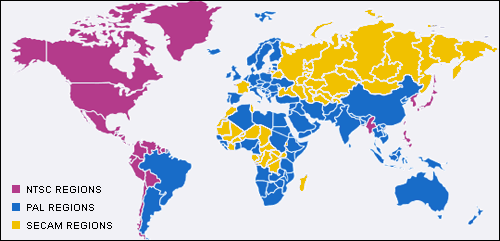PAL, short for Phase Alternating Line, is an analogue television colour encoding system used in broadcast television systems in many countries. Other common analogue television systems are NTSC and SECAM. This page primarily discusses the PAL colour encoding system. The articles on broadcast television systems and analogue television further describe frame rates, image resolution and audio modulation. For discussion of the 625-line / 50 field (25 frame) per second television standard.
In the 1950s, the Western European countries commenced planning to introduce colour television, and were faced with the problem that the NTSC standard demonstrated several weaknesses, including colour tone shifting under poor transmission conditions. To overcome NTSC's shortcomings, alternative standards were devised, resulting in the development of the PAL and SECAM standards. The goal was to provide a colour TV standard for the European picture frequency of 50 fields per second (50 hertz), and finding a way to eliminate the problems with NTSC.
PAL was developed by Walter Bruch at Telefunken in Germany. The format was unveiled in 1963, with the first broadcasts beginning in the United Kingdom in 1964 and Germany in 1967, though the one BBC channel initially using the broadcast standard only began to broadcast in colour from 1967. Telefunken PALcolor 708T was the first PAL commercial TV set. It followed by Loewe S 920 & F 900.
The name "Phase Alternating Line" describes the way that the phase of part of the colour information on the video signal is reversed with each line, which automatically corrects phase errors in the transmission of the signal by cancelling them out, at the expense of vertical frame colour resolution. Lines where the colour phase is reversed compared to NTSC are often called PAL or phase-alternation lines, which justifies one of the expansions of the acronym, while the other lines are called NTSC lines. Early PAL receivers relied on the human eye to do that cancelling; however, this resulted in a comb-like effect known as Hanover bars on larger phase errors. Thus, most receivers now use a chrominance delay line, which stores the received colour information on each line of display; an average of the colour information from the previous line and the current line is then used to drive the picture tube. The effect is that phase errors result in saturation changes, which are less objectionable than the equivalent hue changes of NTSC. A minor drawback is that the vertical colour resolution is poorer than the NTSC system's, but since the human eye also has a colour resolution that is much lower than its brightness resolution, this effect is not visible. In any case, NTSC, PAL, and SECAM all have chrominance bandwidth (horizontal colour detail) reduced greatly compared to the luminance signal.
NTSC receivers have a tint control to perform colour correction manually. If this is not adjusted correctly, the colours may be faulty. The PAL standard automatically cancels hue errors by phase reversal, so a tint control is unnecessary. Chrominance phase errors in the PAL system are cancelled out using a 1H delay line resulting in lower saturation, which is much less noticeable to the eye than NTSC hue errors.
However, the alternation of colour information — Hanover bars — can lead to picture grain on pictures with extreme phase errors even in PAL systems, if decoder circuits are misaligned or use the simplified decoders of early designs (typically to overcome royalty restrictions). In most cases such extreme phase shifts do not occur. This effect will usually be observed when the transmission path is poor, typically in built up areas or where the terrain is unfavourable. The effect is more noticeable on UHF than VHF signals as VHF signals tend to be more robust.

SECAM is an earlier attempt at compatible colour television which also tries to resolve the NTSC hue problem. It does so by applying a different method to colour transmission, namely alternate transmission of the U and V vectors and frequency modulation, while PAL attempts to improve on the NTSC method.
SECAM transmissions are more robust over longer distances than NTSC or PAL. However, owing to their FM nature, the colour signal remains present, although at reduced amplitude, even in monochrome portions of the image, thus being subject to stronger cross colour. Like PAL, a SECAM receiver needs a delay line.
Countries and territories using PAL B/G or PAL D/K
PAL in Europe: Albania, Germany, Ascension Island, Austria, Belgium, Bosnia and Herzegovina, Croatia, Denmark, Slovenia, Spain, Estonia, Ireland, Faroe Islands, Finland, Gibraltar, Greece, Groenland, Iceland, Italy, Letonia, Liechtenstein, Lithuania, Luxembourg, Macedonia, Malta, Montenegro, Netherlands, Norway, Poland, Portugal, Serbia, Sweden, Switzerland, and Vatican City.
PAL in Asia: Afghanistan, Bahrain, Bangladesh, Brunei, China, Cyprus, Dubai, Gaza and Cisjordania, India, Indonesia, Israel, Jordan, Kuwait, Lebanon, Malaysia, Maldives, Nepal, Oman, Pakistan, Qatar, Singapore, Sri Lanka, Syria, Thailand, Turkey, Saudi Arabia, Yemen.
PAL in Africa: Algeria, Angola, Botswana, Cameroon, Cape Verde, Eritrea, Etiopia, Gambia, Ghana, Guinea, Guinea-Bissau, Kenya, Lesotho, Liberia, Malawi, Mozambique, Namibia, Nigeria, Seychelles, Sierra Leone, Somalia, South Africa, Sudan, Swazilandia, Tanzania, Tristan da Cunha, Uganda, Zambia, Zimbabwe.
PALPAL in Oceania: Australia, Christmas Island, Cook Islands, New Zealand, Norfolk Island, Papua New Guinea, Salomon Islands, Tonga, Vanuatu.
Countries and territories using PAL-I: Hong Kong, Malvinas Islands, Macau, United Kingdom.
Countries and territories using PAL-M: Brazil (NTSC & PAL-M), Laos (SECAM & PAL-M).
Countries and territories using PAL-NC or PAL-N: Argentina (PAL-NC), Paraguay and Uruguay (PAL-N).